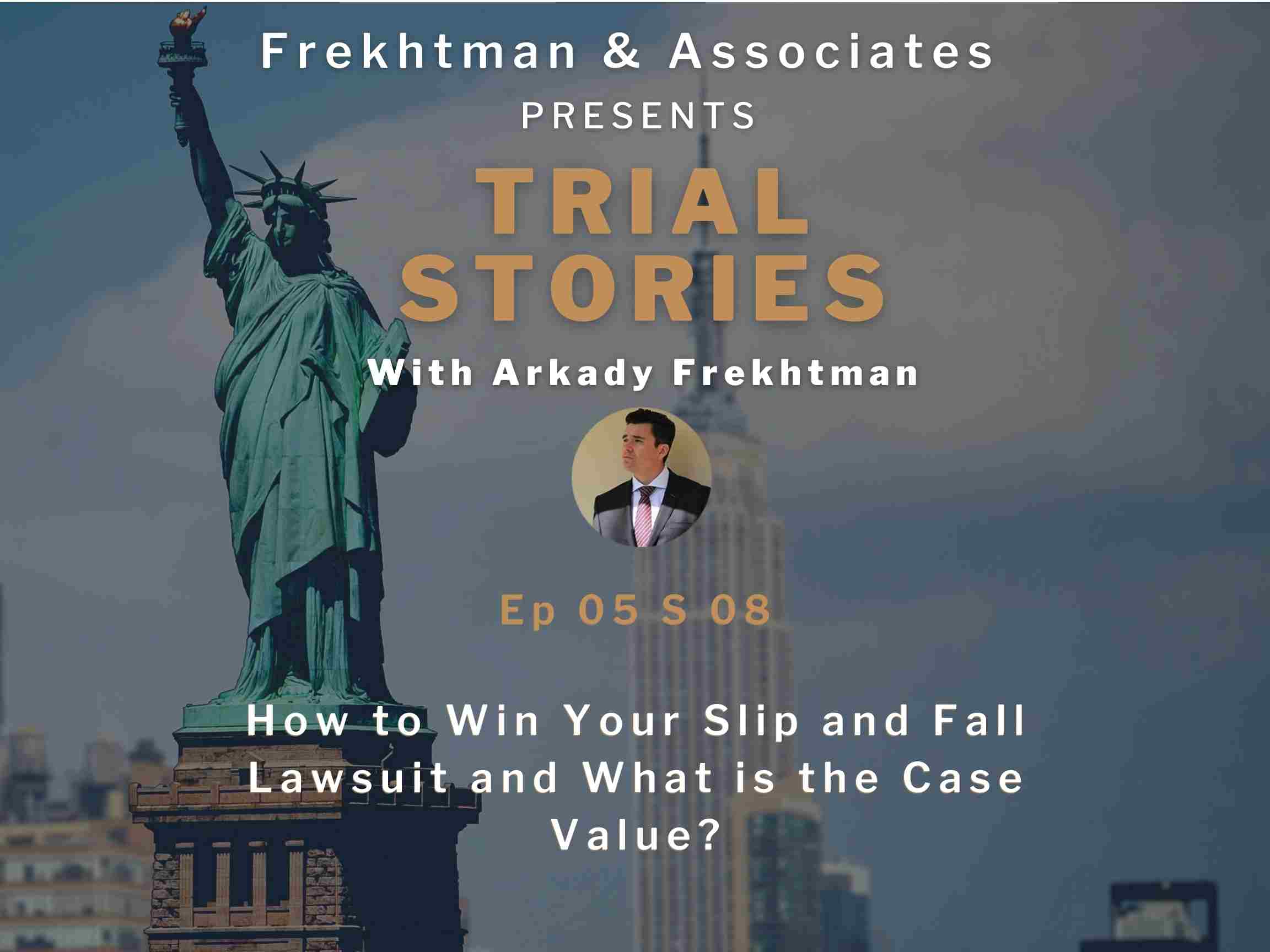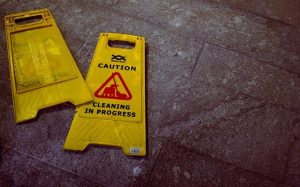EP 05 S 08: How to Win Your Slip and Fall Lawsuit and What is the Case Value?

To Win A Slip And Fall Case, you have got to prove generally that the defect or the water or object or whatever it is you tripped or slipped on was something that the owner of the building either knew about with sufficient time before you fell or should have known about it. Listen to our last podcast episode to learn more
Pick Your Favorite Channel: Apple Podcast | Google Podcasts | Spotify | Stitcher | RSS
Full Transcript
Hi, everybody. This is Arkady Frekhtman, a New York City personal injury trial attorney. And today, we’re talking about slip and falls and premises liability cases. How do you prove a premises liability case? How do you win a slip and fall? Well, just like with ceiling collapses, which we did earlier this week, it’s very, very important to be able to prove notice.
And notice is just proving that the defendant knew or should have known the danger, meaning the puddle or the dangerous condition that caused you to fall. And if they knew, if somebody complained, that’s one way, if they should have known constructively, meaning the danger just existed, or maybe it was a recurrent condition that kept happening over and over again, then that also is a way to establish liability.
And then the third way is if they caused and created the condition, meaning they did work or something that led to the condition. For example, a guy’s mopping, and he leaves a puddle, and then you fall on the puddle. Well, you don’t have to prove how long the puddle was there or that somebody complained about it because the guy with the mob created it, right?
And you’re using the cleaning company. So that’s pretty simple. So that’s the way you prove a slip and fall. And what are the common slip and falls, or what are the common premises liability type cases? Well, the common ones that we’ve seen are slips and falls due to puddles.

Or it could be a recurrent condition, meaning it happens over and over again. Whenever it rains, people track in water, and you don’t have any system or policy to deal with it. That was a case we had in a school in Brooklyn that we ended up settling during trial for almost one and a half million dollars, where somebody would track in water repeatedly.
They had policies saying, you have to put mats, you have to address this, and they didn’t do it. And so we were able to settle that case for over a million. One point, almost one point, I think it was $1.4 million. So another case we had was where somebody was walking, and there was black ice and in a parking lot, and he slipped and fell.
And he also had a serious injury, and he ended up needing fusion surgery and that one was, I think $1.8 million. So you can prove liability, and you can definitely recover large amounts in ceiling collapses. And some recent cases we’ve had, some recent cases we had just… yeah, just a few weeks ago, we settled a case, a very, I think this was a tough case.
This was a case where a gentleman fell. He was actually an inspector. Right? So he was an inspector for the city, and he was out on a block, on just a sidewalk, and doing his inspection. And then he tripped and fell because there was a defect. And he couldn’t sue the city, which is very, very important, right?

And if there’s a defect, like a little crack, it’s on you. But if the defect is not on the sidewalk, if it’s on the curb, well, now that’s the city. Or if it’s in the roadway, that’s the city. Roadway cases are hard. But this one was on the curb. Right?
And so what happened was they were saying the defendants, the people we sued, said, “Look, you can’t sue the city because that’s his employer. So you’re out. That’s workers comp. And what do you want from us? The defect is in the curb. That’s the city. That’s not our responsibility to fix.”
So they were offering zero. And what we did was we went to the scene, we took photographs, we hired an expert engineer. We really did a deep dive. And we showed that in one place this defect was a concave little extension. And that extension went into the sidewalk. And we said, “Look, it might have started, it might have had something to do with the curb as well, but look, the defect extends into the sidewalk and that’s your responsibility.”
And he had an injury, I believe he had a surgery either to the shoulder or to the knee. I forget now. I believe it was to the knee. And so because I wasn’t handling this case, another lawyer was handling this case in my firm. And so the case ended up settling for almost $400,000. And I thought that was an excellent result for a case like that.
Because it’s a tough case, first of all, in liability, you could lose. Second of all, the injury is, an arthroscopic surgery is an injury, but usually people are settling those for 75,000. So 400 for an arthroscopic is very, very good.
So that was a recent one that we had. And we had another recent one, I believe up in Westchester where it was actually a fall in the roadway, which are very, very tough cases. And we were still able to recover. I believe that one, we also got over $300,000 because there was a manhole cover. And then the manhole cover was depressed and uneven.

A variety of different kinds of defects. Right? It could be a slip and fall on a puddle, on oil, on any kind of dangerous condition that would cause you to fall. Now you could also have different types of premises liability, meaning something that happens in a building. It could be a hot radiator, something that’s leaking, a radiator could be leaking it could fall because of that.
It could get burned by a radiator or by, sometimes, you have these… What are they called? These pipes that are vertical pipes and they’re not insulated and they get really hot and you can get burned from that. So there are a lot of different types of injuries.
Ceiling collapses, of course. Sometimes appliances might be defective and you tell the landlord or the management company about it and then they don’t fix it and then the defective appliance, like a refrigerator, leaks. And that causes someone to fall. So there’s a lot of variety of types of cases. And sometimes premises liability cases get really interesting and they get very different.
For example, there was one lawyer he actually took a case to trial that I thought was a tough case, and he did very, very well on it. He ended up getting a verdict, I believe, of $60 million. And the way he did it was he showed that the defendant violated their policies. What happened was a lady went, it was her birthday and her and husband wanted to go to a hotel.
And so she went first because of personal reasons, I believe they had a business where they took care of dogs. So the husband had to stay, and watch the dogs for a day, and he was going to go the next day. So she’s in this hotel, she’s actually in her hotel room, and she had plans to have a glass of wine, call and maybe go out to dinner later with some friends.
And so her husband would call her every hour. And then suddenly he’s calling her, and she’s not answering the phone. So he got worried. He called the front desk, and he said, “Can you please do a room check?” And so that’s where the case really happened. Because what ended up happening to this woman is she suffered an aneurysm, a sudden aneurysm stroke, and she just fainted and fell.
And she was in this room, I think at 3:00 PM it happened. And she was in this room. And he called maybe a few hours later, and he informed the front desk of the hotel. So at that point, their policy said, when you have a room check or when there’s an emergency or potential that something could be an emergency, what you’re supposed to do is you’re supposed to send two people.

And he just finished some kind of maintenance work.” So he said, “Why don’t you just go in?” So he opens the door, the maintenance man, and he looks inside, and he says, “Anyone here, anyone here?” And he never even enters the room. And then no one says anything back. So he thinks everything’s fine. So he just leaves.
And then she wasn’t found until the next day, right? Until the husband actually showed up at five in the morning the next day. Because when the husband was told, “Well, we did the room check, and everything was fine.” His worries were calm down. He had no reason to worry anymore.
He thought, “Okay, everything’s fine.” But when he ended up showing up the next morning, he found her on the floor and then they called the ambulance, and she was saved. I mean, but what happened was she suffered a horrible brain injury. And the brain injury that she suffered was because of that delay, that eight-hour delay.
And he had experts explain, “If we would’ve found her earlier than this hydrocephalus that she suffered, this aneurysm would’ve been contained and it would not have had so much pressure on the brain.” Because what ended up happening is because of the horrific injury, she can’t remember anything for five minutes.
So every five minutes, she doesn’t even know who her husband is. She thinks that she might have to go back to a job that she hasn’t had for 30 years. All her memory is just completely eviscerated. So it’s a really, really life-changing, horrific injury where she’s going to have life care planners, and she’s going to have so many expenses, and it’s just a horrible thing.
So but the defense was, well, first, they tried to blame the husband. Well, why didn’t he come earlier? Or they said, “Look, we did the check. The guy was a little bit nervous, he didn’t know. Maybe she was with a man, maybe she was, they were having intercourse or all these things.”
But then what the guy did, I was reading some of the transcripts. Actually, he shared it with me. I thought it was very helpful. What he did was he just kind of focused on their policies. He said, “Look, these are your policies and procedures. And would you agree that safety is your number one policy? So if safety is your number one policy, then you have to be proactive.
And one of the ways that you have to be proactive is you have these procedures, right? These policies. And this is your policy that two people have to go, that they have to check the room. And then they have to be able to say, we checked the room, it was safe, nobody was here, everything is fine.” But they don’t do that, right?
They don’t follow their own policies. So when you get them to say that they have policies and procedures and they don’t follow their own policies, then you establish liability. So he ended up winning, showing that they were negligent, that they failed to use reasonable care and that it caused this horrific injury.
And then the verdict, the total verdict, there were a lot of elements to it, the life care plan, the past pain and suffering, future pain and suffering, and so all these different elements. But altogether it was close to, I think it was over $60 million. This was a case in California. But I thought it was a great result. Because that’s an example of a premises liability case.
Not necessarily a simple slip and fall, a little bit more intricate, but very, very difficult. And when he brought the case, the defense lawyers are saying, “Look, there’s no way. We’re not going to pay anything. This is not a case.” They tried every which way to get it dismissed or to make motions to basically put some kind of spikes in his tires to prevent him from moving the case.

But when you look at the transcript, each part is very short. It’s 20 pages. It’s four, I mean, four pages per four, I guess, four pages on one page. That’s the way they do it, a condensed transcript. But you could read it quickly. And then you see that he’s not wasting time. He’s just getting to the heart of the case every time, getting to the heart of it.
What’s the heart of the case? With the guy he asks, “Look, safety is your number one priority. This is the policy. You didn’t follow the policy.” Boom. He establishes liability. With the doctor, “Hey, how do you know this would not have happened if she was found earlier?” “Well, I know because X, Y, and Z.” Okay. He had neurologists.
So he had a neuro, I believe, psychologist, neuroradiologist, and two or three doctors, all of them saying the same thing. The defendants of course, said this is a different type of injury, and that it would’ve happened anyway. Even if we had found her a minute after the aneurysm, she would’ve had the same result. But it just didn’t hold up. The medicine didn’t support the defendants.
So yeah, I hope this has been helpful. So let us know what questions you have about either slip and fall cases, trip and fall cases. Winter is coming, so there’s going to be a lot more cases with snow and ice. And we could do videos about snow and ice cases like we mentioned that one case that we settled for nearly $2 million, that was a snow and ice case.
We get a lot of different types of liability cases. But it’s important to do a deep dive and to do an investigation early so that you can establish liability. And once you have liability either through an expert or through witnesses, then it’s easy. Right? Like this guy, he had what a lot of people would say was a tough case, but he established everything early.
He saw how they violated their policies. That led to this injury. He had the doctors. And then he’s not afraid of anything, and he gets a huge verdict of 60 million. So it can be done. Not every case is going to be that big, but meaning trip and fall, slip and fall, all these premises cases can be won if they’re worked up the right way and if the evidence is established early. Okay. I hope this has been helpful. Let us know what questions you have, and we are here for you. Okay. Have a great day, everyone. Bye-bye.
Video Version:

Contact our team at (212) 222-1111 for your free case evaluation.




